Project Lombok is a popular library that helps us to write clear, concise, and less repetitive Java code. However, among the developer community, it has been both embraced and criticized for reasons I would like to elaborate here.
In this article, we will focus on factors that will help you make an informed decision about using the library effectively and being wary of its consequences.
Example Code
This article is accompanied by a working code example on GitHub.What is Lombok?
According to official docs, “Project Lombok is a java library that automatically plugs into your editor and build tools, spicing up your Java.”
This library provides a set of user-friendly annotations that generate the code at compile time, helping the developers save time and space and improving code readability.
IDE Support
All popular IDEs support Lombok. For example, IntelliJ version 2020.3 and above is compatible with Lombok without a plugin. For earlier versions, plugins can be installed from here. Once installed, we need to ensure annotation processing is enabled as in the example configuration below.
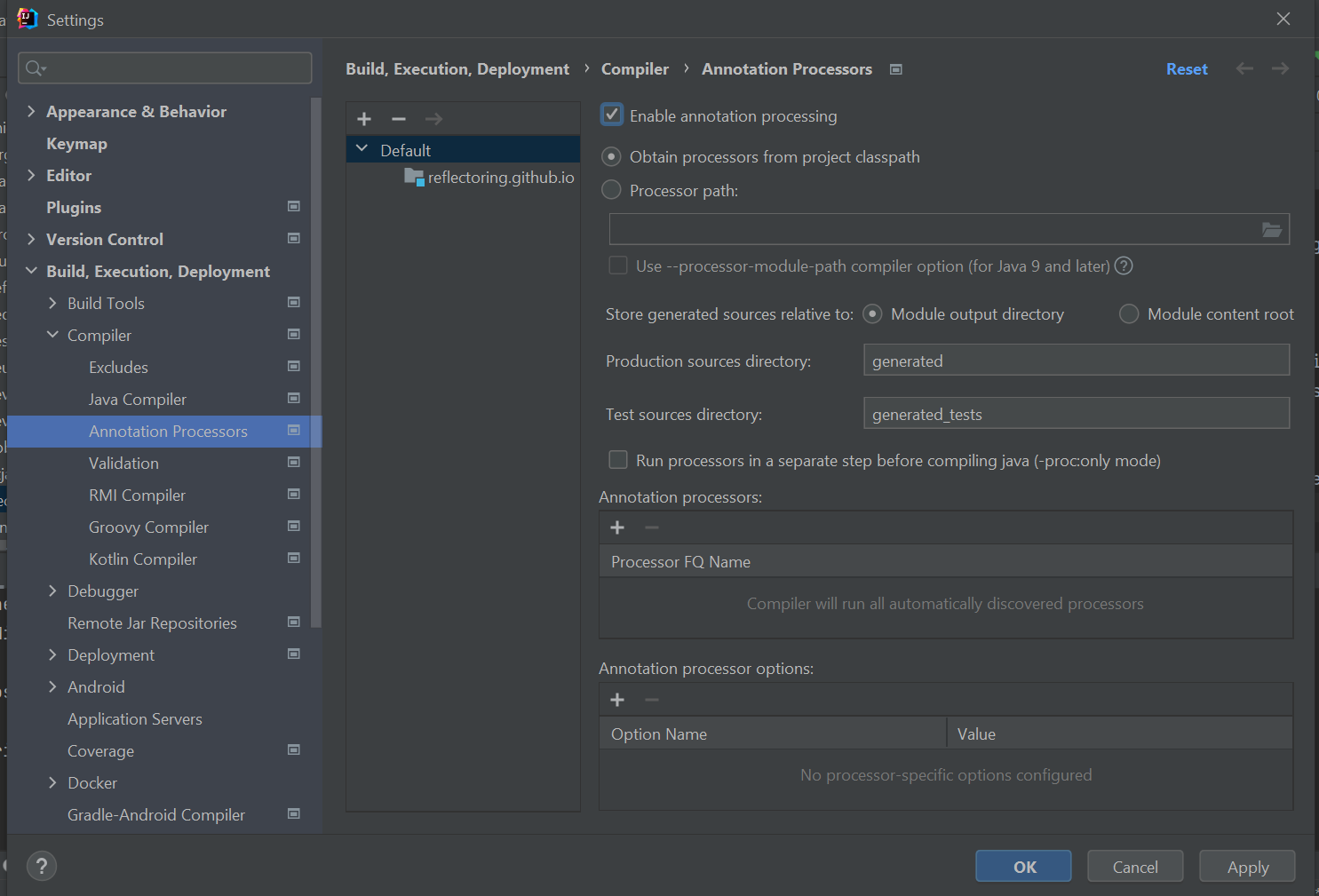
Annotation processing makes it possible for the IDE to evaluate the Lombok annotations and generate the source code from them at compile time.
For Eclipse, go to Help menu > Install new Software > Add https://projectlombok.org/p2. Install the Lombok plugin and restart Eclipse.
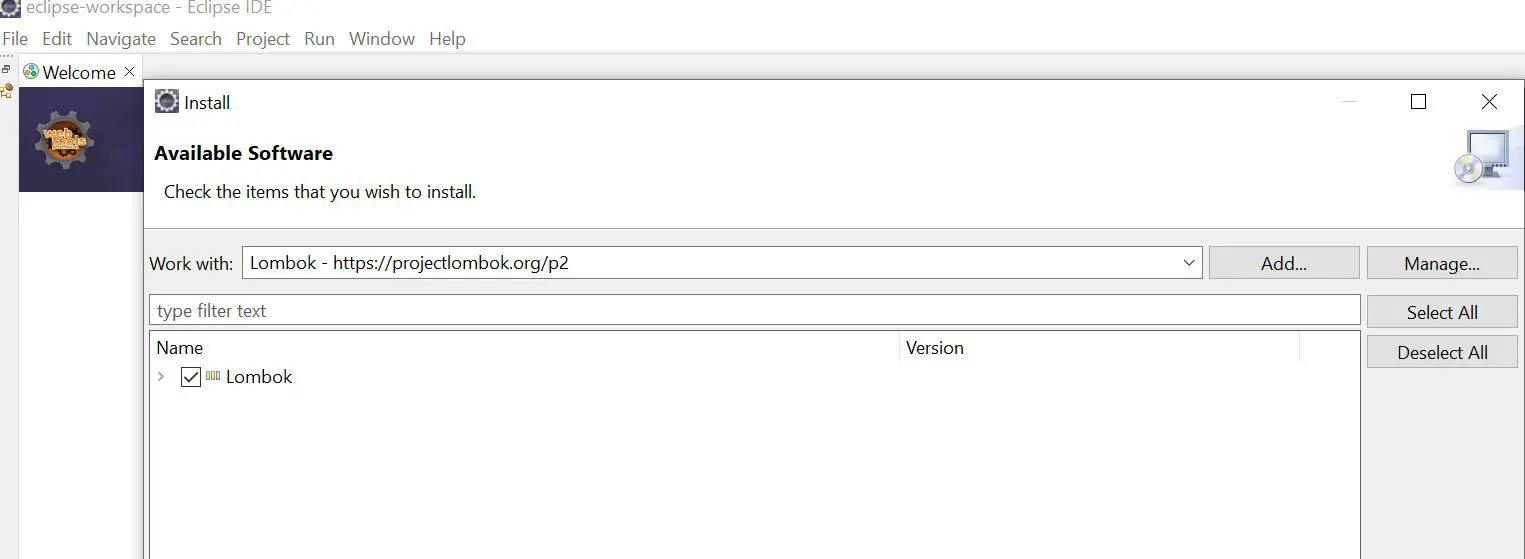
Setting Up a Project with Lombok
To use the Lombok features in a new or an existing project, add a compile-time dependency to lombok as below.
It makes the Lombok libraries available to the compiler but is not a dependency on the final deployable jar:
With Maven:
<dependency>
<groupId>org.projectlombok</groupId>
<artifactId>lombok</artifactId>
<version>1.18.20</version>
<scope>provided</scope>
</dependency>
With Gradle:
compileOnly group: 'org.projectlombok', name: 'lombok', version: '1.18.20'
As an example, consider the below java class:
public class Book {
private String isbn;
private String publication;
private String title;
private List<Author> authors;
public Book(
String isbn,
String publication,
String title,
List<Author> authors) {
// Constructor logic goes here
}
// All getters and setters are explicitly defined here
public String toString() {
return "Book(isbn=" + this.getIsbn()
+ ", publication=" + this.getPublication()
+ ", title=" + this.getTitle()
+ ", authors=" + this.getAuthors()
+ ", genre=" + this.getGenre() + ")";
}
}
Using Lombok, we can simplify the above plain Java class to this:
@Getter
@Setter
@AllArgsConstructor
@ToString
public class Book {
private String isbn;
private String publication;
private String title;
private List<Author> authors;
}
The above code looks much cleaner and easier to write and understand.
How Lombok Works
All annotations in Java are processed during compile time by a set of annotation processors. The Java specification publicly does not allow us to modify the Abstract Syntax Tree (AST). It only mentions that annotation processors generate new files and documentation.
Since the Java Compiler Specification does not prevent annotation processors from modifying source files, Lombok developers have cleverly used this loophole to their advantage. For more information on how annotation processing in Java works, refer here.
Advantages of Lombok
Let’s look at some of the most prominent benefits of using Lombok.
Clean Code
With Lombok, we can replace boiler-plate code with meaningful annotations. They help the developer focus on business logic.
Lombok also provides some annotations that combine multiple other annotations (like @Data combines @ToString, @EqualsAndHashCode, @Getter / @Setter, and @RequiredArgsConstructor), so we don’t have to “pollute” our code with too many annotations.
Since the code is more concise, modifying and adding new fields doesn’t require so much typing. A list of all available annotations is available here.
Simple Creation of Complex Objects
The Builder pattern is used when we need to create objects that are complex and flexible (in constructor arguments).
With Lombok, this is achieved using @Builder.
Consider the below example:
@Builder
public class Account {
private String acctNo;
private String acctName;
private Date dateOfJoin;
private String acctStatus;
}
Let’s use Intellij’s “Delombok” feature to understand the code written behind the scenes.
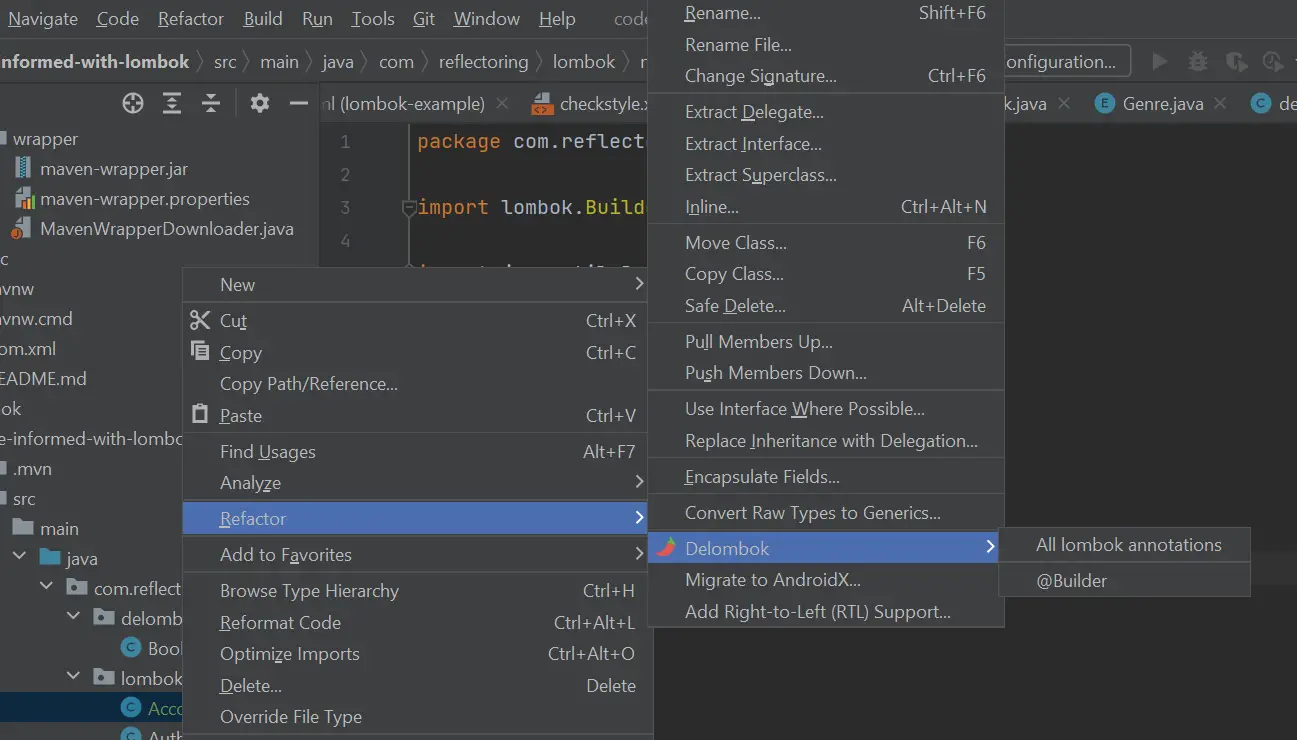
public class Account {
private String acctNo;
private String acctName;
private String dateOfJoin;
private String acctStatus;
Account(String acctNo, String acctName, String dateOfJoin, String acctStatus) {
this.acctNo = acctNo;
this.acctName = acctName;
this.dateOfJoin = dateOfJoin;
this.acctStatus = acctStatus;
}
public static AccountBuilder builder() {
return new AccountBuilder();
}
public static class AccountBuilder {
private String acctNo;
private String acctName;
private String dateOfJoin;
private String acctStatus;
AccountBuilder() {
}
public AccountBuilder acctNo(String acctNo) {
this.acctNo = acctNo;
return this;
}
public AccountBuilder acctName(String acctName) {
this.acctName = acctName;
return this;
}
public AccountBuilder dateOfJoin(String dateOfJoin) {
this.dateOfJoin = dateOfJoin;
return this;
}
public AccountBuilder acctStatus(String acctStatus) {
this.acctStatus = acctStatus;
return this;
}
public Account build() {
return new Account(acctNo, acctName, dateOfJoin, acctStatus);
}
public String toString() {
return "Account.AccountBuilder(acctNo=" + this.acctNo + ", acctName=" + this.acctName + ", dateOfJoin=" + this.dateOfJoin + ", acctStatus=" + this.acctStatus + ")";
}
}
}
The code written with Lombok is much easier to understand than the one above which is too verbose. As we can see, all the complexity of creating the Builder class is hidden from the developer, making the code more precise. Now, we can create objects easily.
Account account = Account.builder().acctName("Savings")
.acctNo("A001090")
.build();
Creating Immutable Objects Made Easy
Once created, an immutable object cannot be modified. The concept of immutability is vital when creating a Java application. Some of its benefits include thread safety, ease of caching, and ease of object maintainability. To understand why it is a good idea to make classes immutable refer to this article.
Lombok provides the @Value annotation to create immutable classes:
@Value
public class Person {
private String firstName;
private String lastName;
private String socialSecurityNo;
private List<String> hobbies;
}
Delomboked version is as below:
public final class Person {
private final String firstName;
private final String lastName;
private final String socialSecurityNo;
private final List<String> hobbies;
public Person(String firstName, String lastName, String socialSecurityNo, List<String> hobbies) {
this.firstName = firstName;
this.lastName = lastName;
this.socialSecurityNo = socialSecurityNo;
this.hobbies = hobbies;
}
public String getFirstName() {
return this.firstName;
}
public String getLastName() {
return this.lastName;
}
public String getSocialSecurityNo() {
return this.socialSecurityNo;
}
public List<String> getHobbies() {
return this.hobbies;
}
public boolean equals(final Object o) {
// Default equals implementation
}
public int hashCode() {
// default hashcode implementation
}
public String toString() {
return "Person(firstName=" + this.getFirstName() + ", lastName=" + this.getLastName() + ", socialSecurityNo=" + this.getSocialSecurityNo() + ", hobbies=" + this.getHobbies() + ")";
}
}
The @Value annotation ensures the state of the object is unchanged once created.
- it makes the class final
- it makes the fields final
- it generates only getters and not setters
- it creates a constructor that takes all fields as an argument
In other words, the @Value annotation is a shorthand for using all of these annotations:
@Getter,@FieldDefaults(makeFinal=true, level=AccessLevel.PRIVATE),@AllArgsConstructor,@ToString, and@EqualsAndHashCode.
We can further enforce immutability in the above example by adding @AllArgsConstructor(access = AccessLevel.PRIVATE) to make the constructor private and force object creation via the Builder pattern.
If you’re looking for a library that generates immutable objects, you should also have a look at the immutables library.
Caveats with Lombok
Above are some benefits of using Lombok. By now you would have realized the value these annotations can provide to your code. However, in my experience of using Lombok, I have noticed developers misusing these annotations and using them across the whole codebase, making the code messy and prone to errors.
Let’s look at some situations where Lombok could be used incorrectly.
Using Lombok with JPA Entities
Although using Lombok to generate boilerplate code for entities is attractive, it does not work well with JPA and Hibernate entities. Below are a few examples of what could go wrong when using Lombok with JPA.
Avoid @ToString
The seemingly harmless @ToString could do more harm to our application than we would expect. Consider the below entity classes:
@Entity
@Table(name = "BOOK")
@Getter
@Setter
@ToString
public class Book {
@Id
private long id;
private String name;
@ManyToMany(cascade = CascadeType.PERSIST, fetch = FetchType.LAZY)
@JoinTable(name = "publisher_book", joinColumns = @JoinColumn(name = "book_id", referencedColumnName = "id"), inverseJoinColumns = @JoinColumn(name = "publisher_id", referencedColumnName = "id"))
private Set<Publisher> publishers;
}
@Entity
@Getter
@Setter
@Builder
@ToString
public class Publisher implements Serializable {
@Id
private long id;
private String name;
@ManyToMany(mappedBy = "publishers")
private Set<Book> books;
}
As we can see, there is a @ManyToMany relationship that requires a JOIN with another table to fetch data.
The Repository class that fetches data from the table is as below:
@Repository
public interface BookRepository extends JpaRepository<Book, Long> {
}
There are three main problems here:
- In an entity class, not all attributes of an entity are initialized. If an attribute has a
FetchTypeofLAZY, it gets invoked only when used in the application. However,@ToStringrequires all attributes of an entity and would trigger the lazy loading, making one or multiple database calls. This can unintentionally cause performance issues. - Further, if we call
toString()on the entity outside of the scope of a transaction, it could lead to aLazyInitializationException. - In the case of associations like
@ManyToManybetween 2 entities, logging the entity data could result in evaluating circular references and causing aStackOverflowError. In the example above, theBookentity will try to fetch all authors of the book. TheAuthorentity in turn will try to find all books of the author. This process will keep repeating until it results in an error.
Avoid @EqualsAndHashCode
Lombok uses all non-final attributes to evaluate and override default equals and hashCode. This isn’t always desirable in the case of entities due to the following reasons:
- Most primary keys in the database are auto-generated by the database
during insertion. This can cause issues in the hashCode computation process
as the
IDis not available before the entity has been persisted, causing unexpected results. - Every database record is uniquely identified by its primary key. In such cases using the Lombok implementation of
@EqualsAndHashCodemight not be ideal.
Although Lombok allows us to include and exclude attributes, for the sake of brevity it might be a better option to override these methods (toString(), equals(), hashcode()) ourselves and not rely on Lombok.
Lombok Hides Coding Violations
Consider a snippet of the model class as below:
@Data
@Builder
@AllArgsConstructor
public class CustomerDetails {
private String id;
private String name;
private Address address;
private Gender gender;
private String dateOfBirth;
private String age;
private String socialSecurityNo;
private Contact contactDetails;
private DriverLicense driverLicense;
}
For the project, we have configured a static code analyzer checkstyle that runs as a part of the maven verify lifecycle.
In the case of the above example (that uses Lombok) the code builds without any issues.
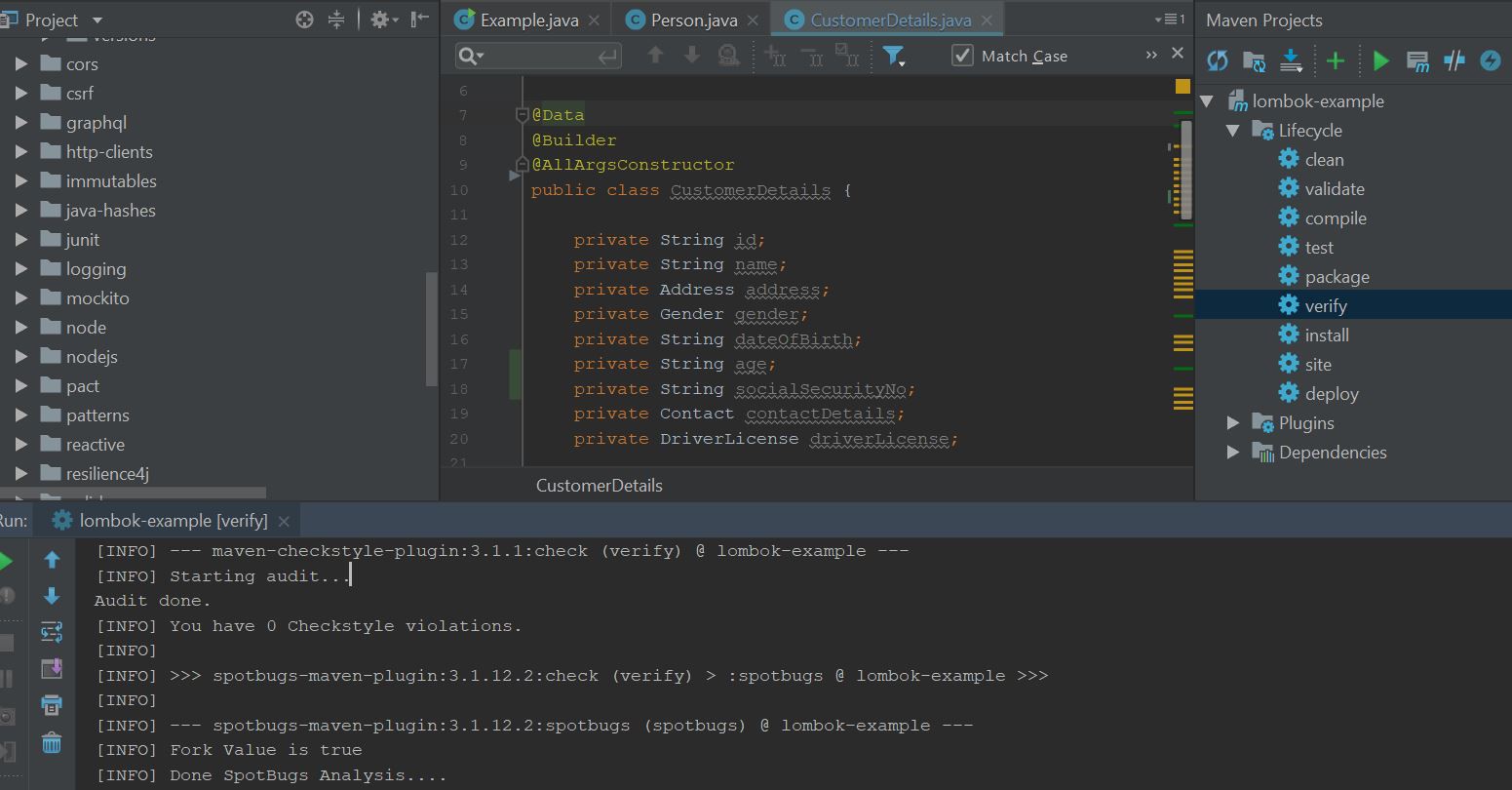
In contrast, let’s replace the same class with its Delomboked version. After the annotations get replaced with their corresponding constructors, we see issues with the static code analyzer as below.
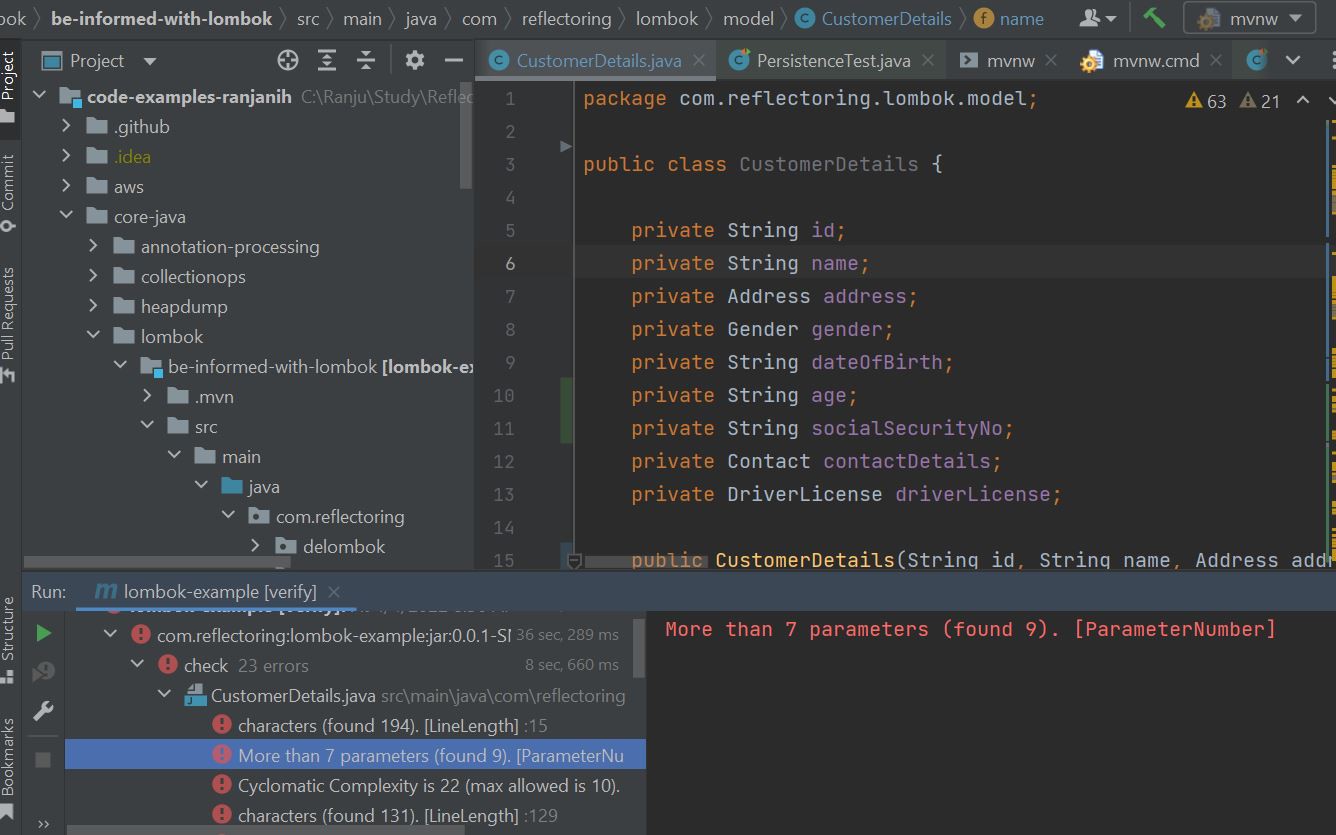
In my experience, I have seen developers use these annotations to escape such violations making it difficult to maintain the code.
Configuration with Code Coverage Tools
Tools such as JaCoCo help create better quality software, as they point out areas of low test coverage in their reports. Using Lombok (that generates code behind the scenes), greatly affects its code coverage results. Additional configuration is required to exclude Lombok-generated code.
@AllArgsConstructor May Introduce Errors When Refactoring
Consider an example class:
@AllArgsConstructor
public class Customer {
private String id;
private String name;
private Gender gender;
private String dateOfBirth;
private String age;
private String socialSecurityNo;
}
Let’s create an object of Customer class
Customer c = new Customer(
"C001",
"Bryan Rhodes",
Gender.MALE,
"1986/02/02",
"36",
"07807789");
Here, we see that most of the attributes have String as their type. It is easy to mistakenly create an object whose params are out of order like this:
Customer c = new Customer(
"C001",
"Bryan Rhodes",
Gender.MALE,
"36",
"1986/02/02",
"07807789");
If validations are not in place for the attributes, this object might propagate as is in the application.
Using @Builder here might avoid such errors.
@Builder Allows Creation of Invalid Objects
Consider a model as below:
@Builder
public class Job {
private String id;
private JobType jobType;
}
public enum JobType {
PLUMBER,
BUILDER,
CARPENTER
}
For this class, we could construct an object as
Job job = Job.builder()
.id("5678")
.build();
Although the code compiles, the object job here is in an invalid state because we do not know which JobType it belongs to.
Therefore, along with using the @Builder annotation, it is also important to enforce required attributes to have a value.
To do this we could consider using the @NonNull annotation.
With this annotation in place we now get the below error:
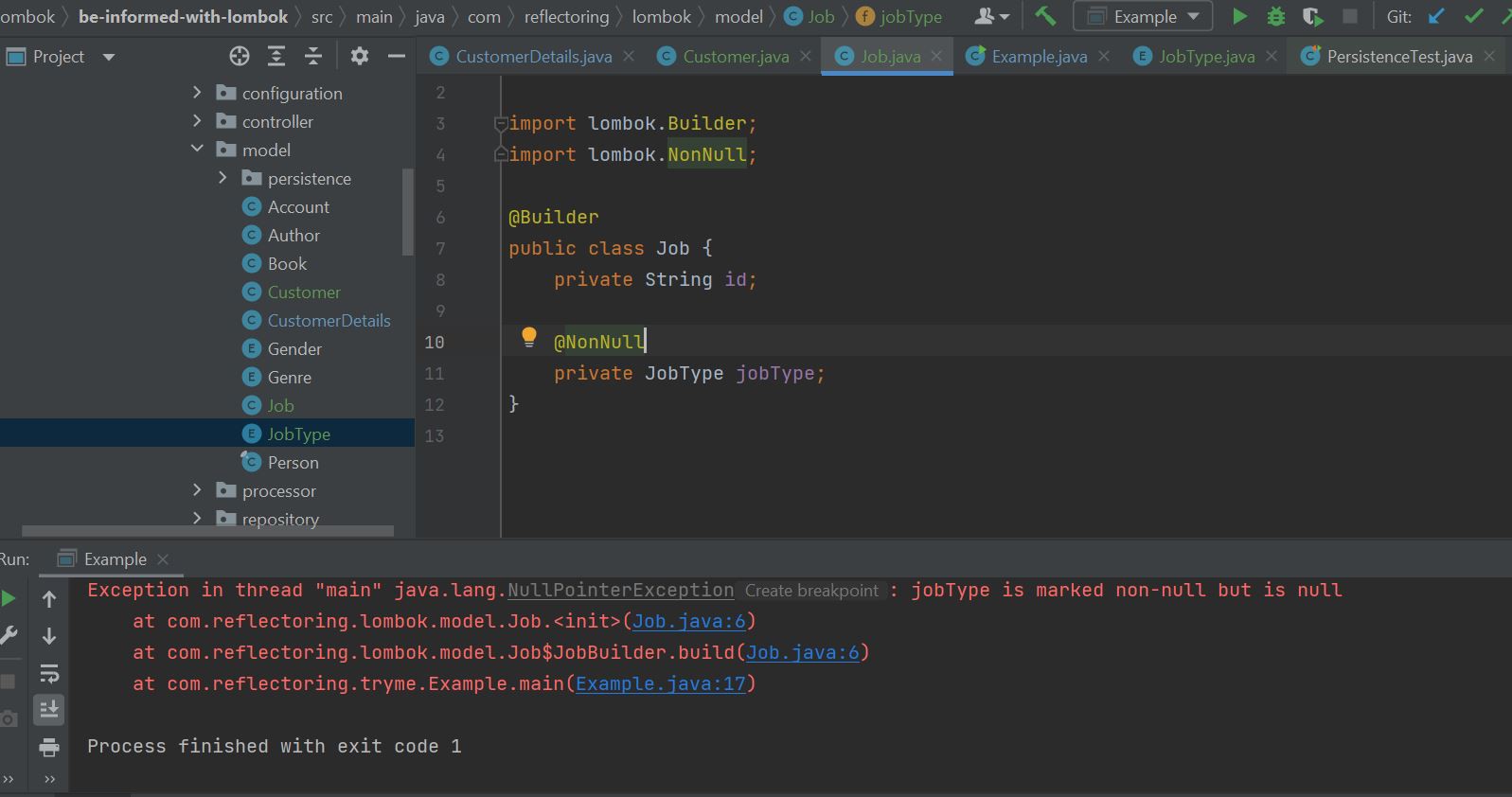
An object created with this approach would now be considered valid.
For more advanced validation scenarios, you could consider using the Bean Validation API.
Application Logic Should Not Depend on the Generated Code
Apart from following good programming practices, developers try to generalize features to ensure re-usability. However, these features should NEVER depend on the code that Lombok generates.
For instance, consider we create a base feature that uses reflection to create objects.
The DTOs use @Builder, and we use the Lombok-generated code in it. If someone decides to create new DTOs
that use @Builder(setterPrefix = "with"), this could be catastrophic in huge, complex applications, because the feature using reflection will be broken.
Since Lombok provides a lot of flexibility in the way objects are created, we should be equally responsible and use them appropriately.
Use @SneakyThrows Cautiously
@SneakyThrows can be used to sneakily throw checked exceptions without declaring it in the “throws” clause. Lombok achieves this by faking out the compiler. It relies on the fact that the forced check applies only to the compiler and not the JVM. Therefore, it modifies the generated class file to disable the check at compile time thus treating checked exceptions as unchecked.
To understand better, let’s first consider this example:
public interface DataProcessor {
void dataProcess();
}
Without @SneakyThrows an implementation of DataProcessor would be like this:
public class FileDataProcessor implements DataProcessor {
@Override
public void dataProcess() {
try {
processFile();
} catch (IOException e) {
e.printStackTrace();
}
}
private void processFile() throws IOException {
File file = new ClassPathResource("sample.txt").getFile();
log.info("Check if file exists: {}", file.exists());
return FileUtils.readFileToString(file, "UTF-8");
}
}
With @SneakyThrows the code gets simplified
public class FileDataProcessor implements DataProcessor {
@Override
public void dataProcess() {
processFile();
}
@SneakyThrows
private void processFile() {
File file = new ClassPathResource("sample.txt").getFile();
log.info("Check if file exists: {}", file.exists());
return FileUtils.readFileToString(file, "UTF-8");
}
}
As we can see, @SneakyThrows avoids the hassle of catching or throwing checked exceptions. In other words, it treats a checked exception like an unchecked one.
This can be useful, especially when writing lambda functions making the code concise and clean.
However, use @SneakyThrows only when you don’t intend to process the code selectively depending on the kind of Exception it throws.
For instance, if we try to catch IOException after applying @SneakyThrows, we would get the below compile-time error

The invisible IOException gets propagated, which could then be handled down the call stack.

Further, we could build logic to read the file content and parse them to dates which might result in DateTimeParseException. Bubbling up such
checked exceptions and using @SneakyThrows to escape its handling might make it difficult to trace errors. Therefore, be careful when using this annotation to escape multiple checked exceptions.
Use Lombok with Caution
The power of Lombok cannot be underestimated or ignored. However, I would like to summarise the key points that will help you use Lombok in a better way.
- Avoid using Lombok with JPA entities. It will be much easier generating the code yourself than debugging issues later.
- When designing POJO’s use only the Lombok annotations you require (use shorthand annotations sparingly). I would recommend using the Delombok feature to understand the code generated better.
@Buildergives a lot of flexibility in object creation. This can cause objects to be in an invalid state. Therefore, make sure all the required attributes are assigned values during object creation.- DO NOT write code that could have a huge dependency on the background code Lombok generates.
- When using test coverage tools like Jacoco, Lombok can cause problems since Jacoco cannot distinguish between Lombok-generated code and normal source code and configure them accordingly.
- Use
@SneakyThrowsfor checked exceptions that you don’t intend to selectively catch. Otherwise, wrap them in runtime exceptions that you throw instead. - Overusing
@SneakyThrowsin an application could make it difficult to trace and debug errors.



